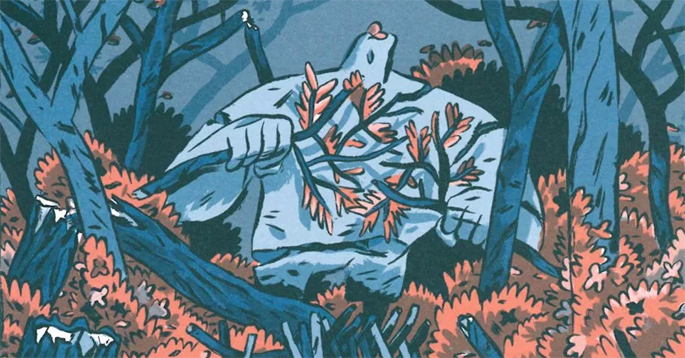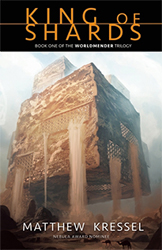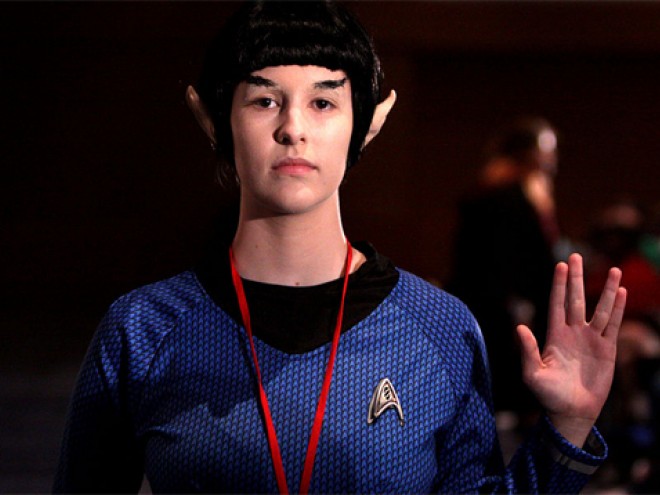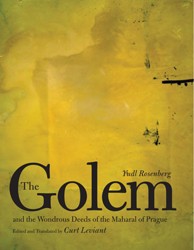Earlier this week, Matthew Kressel explored the Jewish sources underlying Leonard Nimoy’s Vulcan salute and fantasy literature’s greatest time-traveling epics. He is guest blogging for the Jewish Book Council all week as part of the Visiting Scribe series here on The ProsenPeople.
 Image from Golemchik by Will Exley (Nobrow, 2015)
Image from Golemchik by Will Exley (Nobrow, 2015)
The Jews living in Prague in the sixteenth century suffered pogrom after violent pogrom, and so their leader, Rabbi Judah Loew prayed to God for a way to protect his people. In a dream, God showed the rabbi how to craft a golem from the clay of a riverbank, how to animate him by using one of the secret magical names of God inscribed on parchment and placed in the mouth of the form. There was one caveat, however: Rabbi Loew could not use his Golem on the Sabbath, when all work is forbidden.
 One Sabbath, Rabbi Loew forgot to remove the parchment from the Golem’s mouth, and because the Golem was a creature of magic, he became an abomination. Raging and out of control, the Golem killed many people, Jew and gentile, before Rabbi Loew was able to remove the scrap of parchment, disabling the man-made monster. Terrified of his creation, Rabbi Loew hid the creature away in the attic of the Old New Synagogue, where it remains, according to legend, to this day.
One Sabbath, Rabbi Loew forgot to remove the parchment from the Golem’s mouth, and because the Golem was a creature of magic, he became an abomination. Raging and out of control, the Golem killed many people, Jew and gentile, before Rabbi Loew was able to remove the scrap of parchment, disabling the man-made monster. Terrified of his creation, Rabbi Loew hid the creature away in the attic of the Old New Synagogue, where it remains, according to legend, to this day.
The Golem story is a cautionary tale. One should not attempt to play God, it says. This myth enters pop culture most notably in Mary Shelly’s 1818 Frankenstein, which is considered one of the first modern works of science fiction. While the settings and characters are different, the story shares many similarities: Dr. Frankenstein, like Rabbi Loew, sets out to create life from non-life, only to lose control of his creation. Both stories end with the creature waging brutal violence on innocents. We see this plot again in Kubrick’s 2001: A Space Odyssey, in which Hal 9000, a sentient computer, is the ultimate golem: created by man, the computer gains independence from his creators and murders the crew of The Discovery. I’m not sure if Kubrick was familiar with the Golem of Prague story — I suspect he was — but if you re-watch 2001: A Space Odyssey and look carefully, you can spot the exact moment the scientists forget to pull the parchment from Hal’s mouth, so to speak, and lose control of their creation.
In John Carpenter’s Terminator, another computer called Skynet gains sentience and instantly decides humanity is a plague that needs to be wiped out. It initiates a nuclear war and sends very human-looking robots to destroy the survivors, golems if there ever were. The story repeats in Ridley Scott’s Blade Runner, where replicants are not only indistinguishable from humans but smarter and stronger too. When the replicants discover they are not real humans and will soon die, they react violently. In the reboot of Battlestar Galactica, the cylons, also indistinguishable from humans, initiate nuclear war a la Skynet in order to gain freedom from humanity’s yoke. In last year’s Ex Machina, a very humanlike robot uses human empathy to manipulate a stand-in for the viewer, to horrific ends. As these stories approach the present day, the golems appear more and more human, their rebellions ever more and more violent and absolute.
But the myth doesn’t end with fiction. The golem has entered the realm of plausibility. Visionary entrepreneur Elon Musk warned of runaway artificial intelligence, “We have to make sure that we don’t do something very foolish. With artificial intelligence we’re summoning the demon.” In other words, we have to be careful we don’t into being a creature we cannot control, a creature who will wreak violence upon us. The name for that creature is Golem. It is Skynet and it is Hal 9000 and it is Frankenstein’s monster, and it’s Rabbi Loew’s Golem all over again.
So if we are God’s golems, as it were, created from clay and filled with the spirit of life, what does that say about our most popular golem stories, where the created one rebels against its creator, often obliterating him? These golem stories, taken in this context, can be viewed as powerful reflections of our shifting relationship with the Creator and how we are continuing to question and challenge the role of God in our lives, certainly a very Jewish thing to do.
Matthew Kressel is a short fiction writer and the co-host of the Fantastic Fiction at KGB reading series in Manhattan with Ellen Datlow. His first novel, King of Shards, was released October 2015 from Arche Press.
Related Content:
- Matthue Roth: A Lonely Golem
- Benjamin Moser: A Golem in Brazil
- Helene Wecker: Under the Influence of Golems
Matthew Kressel is the author of the Jewish-themed fantasy epic King of Shards. He is a prolific writer of short fiction, his works appearing in the publications Clarkesworld, Lightspeed, Nightmare, io9.com, Interzone, Apex Magazine, the anthologies Naked City, The People of the Book, After, and elsewhere. He is the co-host of the Fantastic Fiction at KGB reading series in Manhattan with Ellen Datlow, and he is (slowly) learning the Yiddish language. By day he writes code for corporations and universities.
Surviving Leonard Nimoy’s Superhuman Salute
Golem Stories, from Mysticism to Fiction to the Realm of Plausibility



